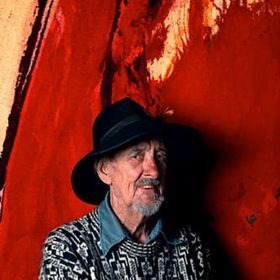framed dimensions: 46 x 53 cm
signed lower right
EXHIBITED:
Sax Shaw Memorial Exhibition, Whitespace Gallery, Edinburgh, 2012, cat.19
Likely conceived as a design for stained glass, mural or tapestry, Dancing Figures features four dancers encircling
a seated musician, all bound within a swirling yellow ribbon which animates the composition with rhythm and movement. Created during Shaw’s tenure as Director of the Edinburgh Tapestry Company (now Dovecot Studios), the painting reflects his deep engagement with art and design. Painted in the 1950s and reflecting aesthetic influences from Jankel Adler and other Polish émigré artists, this work belongs to a moment when large-scale murals and architectural centrepieces played a central role in public art and cultural regeneration. This intimate study captures the spirit of celebration and artistic ambition that defined a generation determined to move forward into a new era.

Sax Shaw was born in Berry Brow, Yorkshire, in 1916 and trained at Huddersfield School of Art before choosing to study at Edinburgh College of Art, where he found a thriving stained-glass department. Though offered a place at the Royal College of Art, London, Shaw was drawn to Edinburgh’s commitment to architectural design and contextual craftsmanship. Following wartime service as a conscientious objector, he returned to Edinburgh College of Art and began working in theatre design, tapestry, and stained glass, often in collaboration with his wife, Maisie Mallinson. In 1947–48, Shaw visited Paris on a scholarship and was welcomed into the Gobelins tapestry studios, experiences that would shape his approach to weaving and solidify his belief in the artistic role of the designer-weaver. His subsequent appointment in 1953 as Director of Weaving at The Edinburgh Tapestry Company (now Dovecot Studios) marked the beginning of a radical shift in British tapestry, as Shaw championed a modern, expressive use of texture, narrative, and abstraction.
As a teacher at Edinburgh College of Art from 1948 to 1981, and as a visiting lecturer across Scotland, Shaw shaped generations of designers and stained-glass artists. Shaw’s work ranged across disciplines – tapestry, stained glass, mural painting, mosaics, church furnishings, watercolour, and costume design, yet his voice remained unmistakable; playful, rigorous, spiritual, and deeply embedded in the life of buildings and spaces.